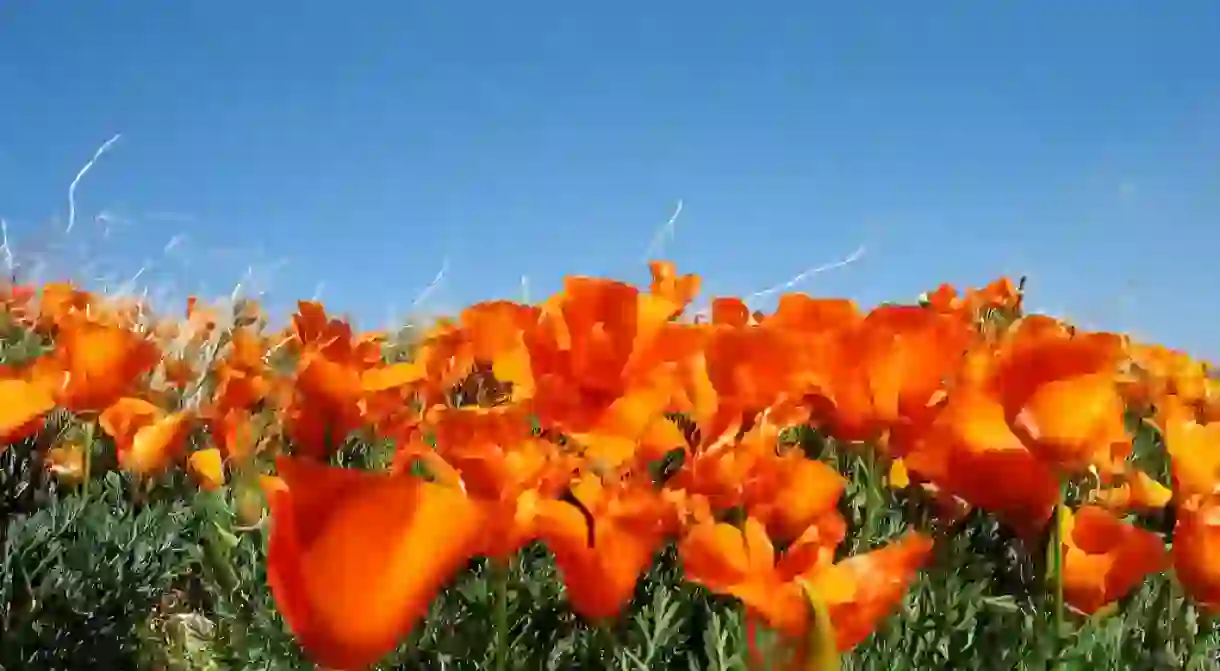5 Reasons to Visit the Antelope Valley Poppy Reserve

Including, but not limited to, the amazing Instagram photo op.
You know that dreamy scene in The Wizard Oz when Dorothy passes out in a field of magically-drugged poppies? The drugged-by-an-evil-witch part is not great, but the magical field of golden blooms? That is the stuff dreams are made of. And, if you live in the Los Angeles area, it’s a dream that can come true with a visit to the Antelope Valley Poppy Reserve. Here are five reasons to plan a visit now.
https://www.instagram.com/p/Bh6sMLlFLYD/?tagged=antelopevalleypoppyreserve
It’s an unparalleled chance to experience the beauty of nature
First and foremost, the Antelope Valley Poppy Reserve is simply gorgeous—breathtakingly so. The orange and red blooms paint the valley golden. The pictures, as beautiful as they are, don’t do the reserve justice.
Visiting the reserve is guaranteed to be a memory that will last a lifetime. And, for Angelenos, it’s a chance to be immersed in nature in a way that everyday life just doesn’t afford. The drive to the Antelope Valley Poppy Reserve from LA is less than two hours, but it feels like being transported to another world.

California is the only place to see poppies like this
Angelenos are especially lucky when it comes to their proximity to the poppy blooms. The poppy is the official state flower of California, and not just because it’s as golden as the Golden State. The reserve—situated in the northeast corner of LA County, in the hills west of Lancaster—is a protected area because it happens to be the perfect microclimate for the poppies. Which means there is literally no better place in the world for these flowers to thrive and no better place to bask in their beauty.
https://www.instagram.com/p/BhvmMIRlTXc/?tagged=antelopevalleypoppyreserve
The Instagrams from the visit will get so many likes
The Antelope Valley Poppy Reserve has developed a bit of a reputation as Instagram-bait, with many guests coming just for the pictures the visit will yield. Obviously, it’s not ideal to visit a rare state park just for the picture (see every other reason on this list), but as anyone with eyes has to admit, the pictures are pretty incredible. Your grid will thank you.
https://www.instagram.com/p/Bhpv3minMPl/?tagged=antelopevalleypoppyreserve
https://www.instagram.com/p/BhnV0NVAwrN/?tagged=antelopevalleypoppyreserve
https://www.instagram.com/p/BS_edMgBwd-/?tagged=antelopevalleypoppyreserve
The reserve has amazing hiking trails
The beautiful blooms and like-worthy pictures are not the only reasons to visit the Antelope Valley Poppy Reserve. The reserve is surrounded by eight miles of hiking trails, for nature enthusiasts who want a hike with a view. According to Visit California, most guests stick to the 3.3-mile South and North Loop trails and then take a detour to the Tehachapi Vista Point to admire the poppies.
Experts say guests should stop at the visitor center for up-to-date information about where the most flowers are blooming that day (conditions like temperature and wind can change the views from day-to-day and even hour-to-hour). It’s best to find out where the blooms are most beautiful and then plan any trail hiking around that. Whatever path visitors choose, it’s important to stay on the trail—guests aren’t allowed to stray from the trails for pictures. Doing so can result in crushed flowers, compacted soil and years-long damage to the area.
https://www.instagram.com/p/Bh5XDhKAQSC/?tagged=antelopevalleypoppyreserve
It’s easy to turn the visit into a full day trip
Here’s a pro tip: the Day-Use entry ticket that guests have to purchase to visit the reserve is also valid for same day entry to any other California state park that charges the same (or a lower) rate. This means that while Angelenos (or anyone who has made the trek, of course) are in the area, they can visit some of the neighboring state parks.
The first stop day-trippers should make after the Antelope Valley Poppy Reserve is the Arthur B. Ripley Desert Woodland State Park. It’s just seven miles west of the poppy reserve and is a great place to see (and photograph) native Joshua tree and juniper woodland. The park also features two self-guided nature trails where hikers can look out for wildlife.
For the more adventurous, Saddleback Butte State Park is located 32 miles east of the poppy reserve and it’s home to a different species of wildflowers than guests will see at the poppy reserve.
Finally, for anyone willing to really make a day of it, Red Rock Canyon State Park is 60 miles north of the poppy reserve, and the stunning red cliffs are a completely different kind of sight to behold.
https://www.instagram.com/p/Bh98pvlAGmY/?taken-at=321972824884507
State park interpreter Jean Rhyne told Visit California that the Arthur B. Ripley Desert Woodland State Park is the best destination for anyone who drives out for the poppies only to realize they aren’t in bloom (or aren’t as vibrant as they could be). “It’s a native Joshua tree and juniper woodland, so it has different flowers blooming,” Rhyne says. “It’s also more protected from the wind.”













